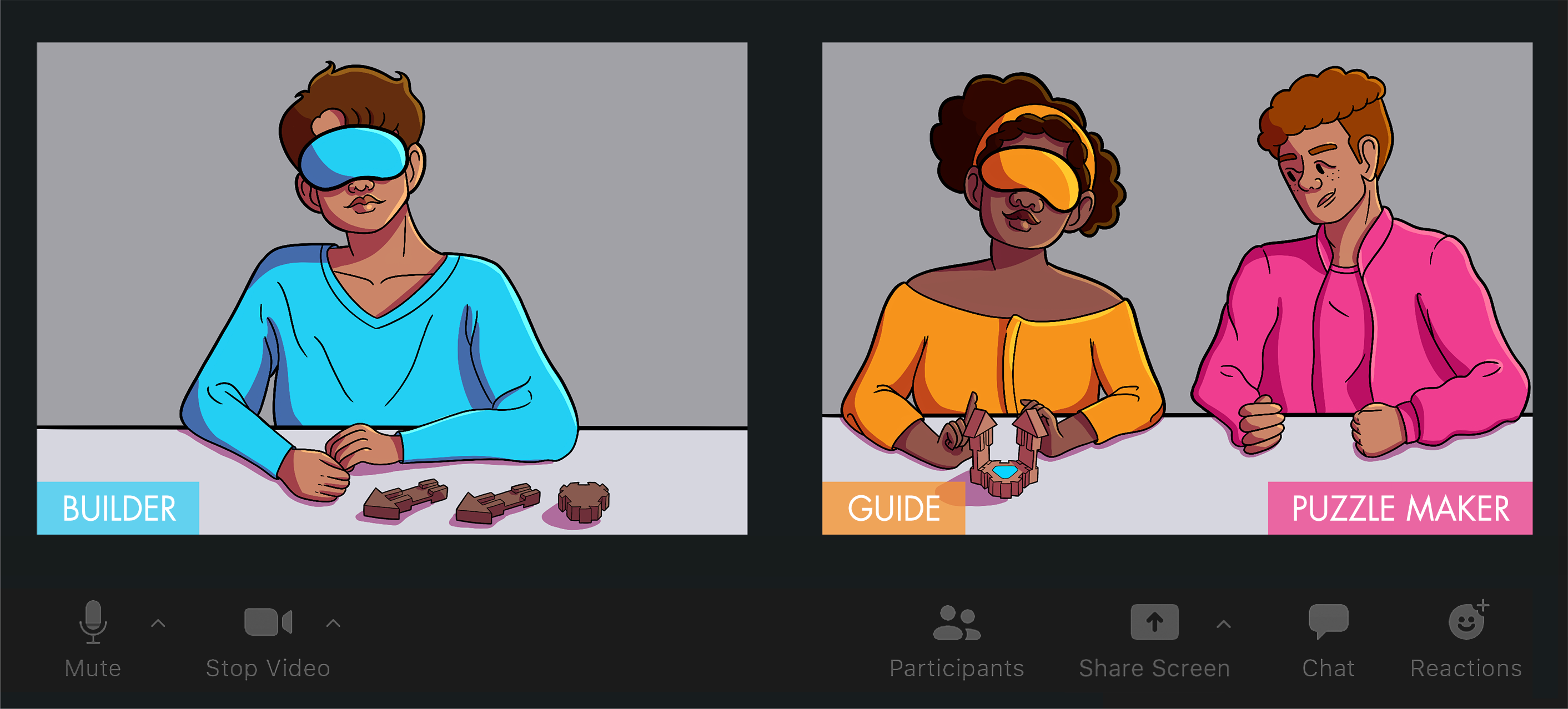Have you tried playing the Empathy Toy® on one of our Empathy Toy® Global Play Sessions and now you'd like to share that experience with friends or colleagues? Or maybe you're used to playing the Empathy Toy® in person and you're curious about how you can keep playing without players being in the same room?
If so, you're in the right place! Keep reading for the rundown on how to play your Empathy Toy® online.
What you’ll need to play:
A minimum of 3 players, 2 of whom need to be in the same location
2 or more Empathy Toys®
Computers with internet access and webcams
Player Roles

Puzzle Maker
As Puzzle Maker, you will create a puzzle pattern for the Guide out of the pieces that came with your Empathy Toy®.
You can use all or just a few of the puzzle pieces - it's entirely up to you how challenging to make the pattern.
You will need to be in the same location as the Guide, so you can hand them the puzzle you have created.
Tip: When deciding how difficult to make the shape, bear in mind that you probably want to remain friends with the other players afterward.
Guide
As the Guide, you will describe the puzzle created by the Puzzle Maker to 1 or more Builders.
Your goal is to help the Builder(s) create the same pattern that you have.
Both you and the Builder(s) will be blindfolded! The Guide and Builder(s) must all put on their blindfolds before the Puzzle Maker creates the puzzle.
Your challenge as the Guide is to describe something that has no name, and that neither you or the Builder(s) have even seen!
Builder
As a Builder, you will assemble your puzzle pieces based on the description from the Guide.
Communicate with the Guide via your preferred video conference platform (Zoom, Google Meet, BlueJeans, etc).
How you interact with the Guide is entirely up to you. Feel free to ask questions, provide feedback, or do whatever else you believe will set you up for success.
Tip: This game gets even more interesting when multiple Builders participate. Different people have different communication and collaboration styles – which becomes very clear as more voices join the game.
How to "Win"
The game concludes when the Guide and Builder(s) believe they have matching puzzle patterns. At this point, they remove their blindfolds and show each other their patterns.
Now the Puzzle Maker, the Guide, and the Builder(s) should have a quick conversation about what they noticed, and how they felt during the game.
Here are 3 questions to guide that conversation:
When were we most successful during our game? What led to that success?
Where did we struggle? What can we do to address these struggles in the next game?
What lesson(s) are important for us to take away from this game?
The value of recurring games
The Empathy Toy® is a fun game, and also a form of social-emotional exercise. And, just like physical exercise, the benefits of the Empathy Toy® become more apparent with continued use.
Here are some tips for continuing to challenge yourself and grow as you use your Empathy Toy® repeatedly:
Play with different people We all communicate and collaborate differently, so each game is as unique as the players who contribute to it. What are the differences you notice when playing with different people? What changes do you need to make in your own approach depending on who you are playing with?
Change up player roles To understand the challenges and privileges of each role, take each for a test drive! What do you notice changing about your overall game strategy as you learn more about what it takes to succeed in each role?
Create challenging patterns As players get more familiar with the game pieces, the Puzzle Maker can get more inventive (or devious, depending on who you ask) with the puzzle patterns they create. Try challenging player assumptions by building patterns that connect in unusual ways – don't limit yourself to the ways that the puzzle pieces look like they "should" connect. How do experienced players deal with puzzle patterns that deviate from the expectations?
Add a time limit This creates added urgency (and stress!) to the game. How does this affect how players communicate and collaborate?
Play with different communication technologies What if the Guide and Builder(s) were sighted, but everyone had their webcam off? How might everyone's communication and collaboration style change when they can only see what they are working on, and not what everyone else is? What if all game instructions took place over text message? What does it take to provide thorough, accurate instruction within the constraints of a character limit?
We hope your next online play session is filled with as much fun as we've been having!
P.S. If you're looking for more opportunities to play online, consider joining us for our next Empathy Toy® Global Play Session.
